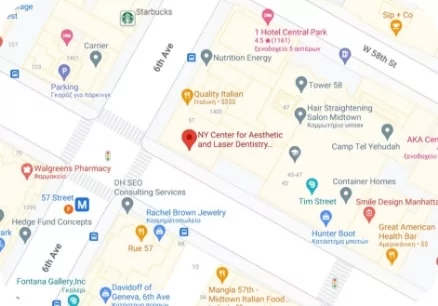Gum Disease is Dangerous Don’t Delay Treating Your Periodontal Disease.

Gum disease is dangerous for your smile and overall health. It can be life-threatening and can cause major issues if not treated in time. This is a disorder that impacts your gums and tissues surrounding your teeth, varying from minor gingivitis to serious periodontitis. At the NY Center for Aesthetic and Laser Dentistry, our expert dentists can treat your gum disease to protect your overall health.
Our expert dentist, Dr. David J. Poiman, uses state-of-the-art technology and advanced techniques to treat your gum disease. He always listens to all your concerns and provides tailored solutions according to your unique needs. We provide a welcoming, stress-free environment for you and your family so you can get the dental health that you need.
At the NY Center for Aesthetic and Laser Dentistry, we focus on treating your entire mouth to improve your overall health. Our Manhattan-based dental practice dedicates itself to providing comprehensive care for gum diseases such as gingivitis and periodontitis.
Call 212-371-1414 to schedule your Gum Disease Consultation NOW and take the first step toward protecting your overall health.
What Causes Gum Disease and Periodontal Disease?
The buildup of plaque and tartar on your teeth primarily causes gum disease. Other factors that contribute to gum disease include:
- Smoking
- Hormonal changes
- Poor nutrition
- Stress
- Genetics
Regular dental checkups and cleanings at the NY Center for Aesthetic and Laser Dentistry are vital in preventing and managing your gum disease. Our expert dentists can check you for gum disease and effectively treat it in time to avoid major health problems. Call us NOW at 212-371-1414, and our warm and friendly team will schedule your gum disease consultation at our dental office.
Key Gingivitis Symptoms
Recognizing the symptoms of gum disease early on in the gingivitis stage can help prevent your gum disease from getting worse. We can potentially reverse your damage before it turns into periodontitis with our expert treatment. You may observe the following symptoms if you have gingivitis:
- Gum Swelling
- Bleeding Gums
- Swollen Gums
- Gum Recession
- Persistent Bad Breath
- Loose Teeth
Schedule your consultation at our Manhattan dentist’s office today if you notice any of these gingivitis symptoms. Our expert dentists and dental team will swiftly tend to your dental needs before you develop symptoms of periodontitis.
How Dangerous is It to Avoid Gum Disease Treatment?
Neglecting gum disease can lead to a host of problems, including tooth loss, receding gums, and bad breath. Additionally, if left untreated, gum disease can even lead from mild gum recession to systemic health issues such as heart disease, diabetes, and stroke. Early intervention and treatment is essential in preventing these complications and preserving your soft tissue and overall health.
Gingivitis and Periodontitis Treatments at Our Manhattan Dentist Office

At NY Center for Aesthetics and Laser Dentistry, we offer a range of treatments for your gum disease. When you meet Dr. Poiman for a consultation, he’ll be able to help determine which methods will work best for your needs. The treatments we offer include all the following:
Scaling and Root Planing — Deep Cleaning
Scaling and root planing, often referred to as deep cleaning, is a non-surgical procedure used to treat gum disease. It involves the removal of plaque and tartar from above and below your gum line and smoothing your root surfaces to prevent bacteria buildup. This procedure is essential in managing gum disease and preventing its progression.
What Is Dental Scaling?
Dental scaling is the process of removing plaque and tartar from the surface of your teeth and below your gum line. Using specialized instruments, the dental hygienist or dentist meticulously cleans the tooth surfaces and pockets between your teeth and gums. This is an essential step in treating gum disease and preventing further complications.
What Is Root Planing?
After removing plaque and tartar through scaling, the roots of your teeth are planed or smoothed. This smoothing process helps to prevent bacteria from adhering to the roots and aids in the reattachment of your gums to your teeth.
When Should I Consider Scaling and Root Planing?
Scaling and root planing should be considered if you have symptoms of gum disease such as red, swollen, or bleeding gums, persistent bad breath, or if your dentist has identified deep pockets between your teeth and gums. Early intervention with scaling and root planing can prevent the progression of gum disease and protect your oral health.
LANAP or LAPT
Laser-Assisted New Attachment Procedure (LANAP)
LANAP utilizes advanced laser technology to precisely remove infected gum tissue while promoting tissue regeneration, effectively treating gum disease with minimal discomfort and reduced recovery time.
Laser-assisted periodontal therapy (LAPT)
LAPT is a minimally invasive procedure that uses laser technology to eliminate bacteria and infected tissue, promoting gum healing and attachment.
While both treatments use lasers for gum disease treatment, LAPT is a broader term encompassing various laser-based periodontal therapies, whereas LANAP specifically targets the new attachment of gum tissue to the root surface.
At-Home Gum Care
We can also provide personalized at-home care plans, including recommendations for oral hygiene products and techniques to maintain your gum health. Our team is committed to helping you achieve and maintain healthy gums through effective treatment and patient education.
Dental Deep Cleaning vs. Routine Dental Cleaning
While routine dental cleaning focuses on the surface of your teeth and is part of your regular oral hygiene, dental deep cleaning is a therapeutic procedure aimed at treating gum disease and gum infection. Deep cleaning includes scaling and root planing and is necessary when there are deep pockets between your teeth and gums or signs of gum infection.
What Does Deep Dental Cleaning Cost?
The cost of scaling and root planning varies depending on the severity of your gum disease and your geographic location. It’s important to consider that this procedure is a necessary investment in your oral and overall health. Most dental insurance plans cover scaling and root planning as it is a therapeutic procedure. Our office can provide you with detailed cost information and discuss payment options upon your consultation.
Why Should I Visit NY Center for Aesthetic and Laser Dentistry for Treatment of My Gingivitis and Periodontitis?
Choosing the right dental practice for gum disease treatment is crucial. At NY Center for Aesthetic and Laser Dentistry in Manhattan, we offer personalized treatment plans tailored to your specific needs. Our clinic is equipped with state-of-the-art technology, and our team is skilled in the latest treatment methods.
We understand the importance of your gum health in relation to overall wellness. We are committed to providing you with the best care possible. Our team will work with you to develop a personalized treatment plan that meets your needs. We excel at patient comfort and satisfaction, ensuring that you receive the highest standard of care!
Get Excellent Periodontal Care at the NY Center for Aesthetic and Laser Dentistry
Don’t let gum disease cause problems to your health. Schedule your gum disease treatment appointment at our Manhattan clinic today!
Call 212-371-1414 NOW and take the first step toward protecting your gums and your overall health.



